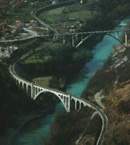 Solkan is a well known town in Slovenia and
abroad. After breaking through the canyon between Sabotin and Skalnica, the Soča river
created the Goriška plain. In the north and south the plain is surrounded by: Solkan is a well known town in Slovenia and
abroad. After breaking through the canyon between Sabotin and Skalnica, the Soča river
created the Goriška plain. In the north and south the plain is surrounded by:
The Italian border crosses Brda, the Goriška plain and the Karst all the way down to Slovensko Primorje. There are several minor and two international border crossings (Rožna dolina and Vrtojba). A modern highway, running along the fertile Vipavska valley, is going to connect Goriška to Razdrto and Ljubljana and in this way enable better exchange of goods and ideas. More about Solkan you can find in our project BRIDGES THE HISTORY OF SOLKAN In 1001 Solkan was for the first time mentioned as Castrum Silicanum. The first settlement was situated around the church of St. Stefan. The houses were arranged in the form of a horse-shoe. For 200 years the parish included also the town of Gorica.In 1705 Marko A. Plenčič, a medical student and an expert on the preservation of corn, was born in Solkan. The square in front of the church is named after him. He died in Vienna, 25th November, 1786.
Then
the world economic crisis came and the strong pressure of fascism. Many joiners emigrated
to Yugoslavia and other countries. In 1932 the joiners who stayed in Solkan established
CAM-comunita Artigliana Mobilieri and they conformed to the demands of the Italian market.
In that period they were given high acknowledgements at the exhibitions. After the Second
World War the co-operative was renamed.In 1948 the forth co-operative was established and
in 1980 it was registered. THE SOLKAN RAILWAY BRIDGE - THE SYMBOL OF OUR TOWN In 1901 the law about the construction of the shortest railway communication of Vienna with the sea came out. It was considered to be the construction of the century. It would cross the Alps, run along Baška grapa and the Soča valley until it reached Triest. The most demanding structure was a 220 m long stone bridge over the Soča river in Solkan. The major arc would have a length of 85 m and the side viaduct that of 41 m. It was considered to be the longest stone bridge then. The bridge served its purpose until August 1916. The Austrian army at Soška fronta went through defeats therefore it received orders to retreat and to destroy all bridges behind it. In 1918 the Austrians began the restoration works and the bridge was used only for slow traffic. Later on, the Italian government decided to restore it for normal traffic. They were restoring it for two years, from 1925 to 1927.The construction of the new road bridge made part of the Osim agreement between Italy and the formal Yugoslavia. The road would connect Goriška brda and Nova Gorica and would be the shortest way of communication between Brda nad the Goriška plain. Thus, the Sabotin road runs along the side of Sabotin, just above the canyon of the Soča river, and through the Italian territory (1 km) to Hum.
Fotografija: dr. R.Podobnik The road bridge is made of concrete and it partly imitates the old railway bridge. It is famous for bungee jumping. OUR CELEBRITIES -SPORTSMEN Solkan is well known for its cultural and historical sights as well as for the successful sportsmen. Some of the best sportsmen in cayaking come from Solkan:
Prepared by: Saša Pervanja
in Kristina Humar, members of geographical group |
 the cherry-tree in blossoms, Goriška brda
the cherry-tree in blossoms, Goriška brda



